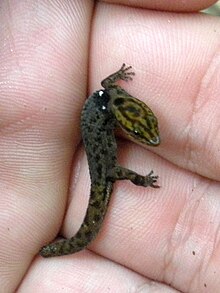
Back Sphaerodactylus macrolepis CEB Sphaerodactylus macrolepis Spanish Sphaerodactylus macrolepis Basque Sphaerodactylus macrolepis French Sphaerodactylus macrolepis Italian 큰비늘땅딸이도마뱀붙이 Korean Nááʼyiłnaadiichilí łikizhígíí NV Sphaerodactylus macrolepis Romanian Крупночешуйчатый круглопалый геккон Russian Sphaerodactylus macrolepis Swedish
| Sphaerodactylus macrolepis | |
|---|---|

| |
| Sphaerodactylus macrolepis | |
| Scientific classification | |
| Domain: | Eukaryota |
| Kingdom: | Animalia |
| Phylum: | Chordata |
| Class: | Reptilia |
| Order: | Squamata |
| Family: | Sphaerodactylidae |
| Genus: | Sphaerodactylus |
| Species: | S. macrolepis
|
| Binomial name | |
| Sphaerodactylus macrolepis Günther, 1859
| |
| Synonyms | |
| |
Sphaerodactylus macrolepis, also known as the big-scaled dwarf gecko or the big-scaled least gecko, is a lizard of the Sphaerodactylus genus. It was first documented in 1859 in the US Virgin Islands, specifically, St. Croix. This diurnal species has since been spotted in other locations such as Puerto Rico with major populations in Culebra.[2]
Additionally, the big-scaled dwarf gecko displays sexual dimorphism with males being larger than females. Furthermore, size, particularly snout vent length, differs depending on the location of the lizard. Those in Puerto Rico are larger than their US Virgin Island counterparts. The big-scaled dwarf gecko is commonly seen on the forest floor of the islands, in their preferred microhabitat of leaf litter.[3] Additionally, the species also exhibits significant sexual dichromatism in which the male and females are unique in coloration. A main difference is the colored head found in males but is lacking in females.[4]
Another notable characteristic of the big-scaled dwarf gecko is their preference for cooler environments due to their miniature size which increases their rate of desiccation. Their total evaporative water loss grows with temperature and so these lizards’ behaviors and location alters during the day in order to seek out appropriate microhabitats.[5]
- ^ Platenberg, R., Joglar, R. & Rodriguez, C. 2016. Sphaerodactylus macrolepis (errata version published in 2017). The IUCN Red List of Threatened Species 2016: e.T75605505A115488645. https://doi.org/10.2305/IUCN.UK.2016-3.RLTS.T75605505A75607799.en. Downloaded on 03 March 2019.
- ^ Rodriguez, Carlos; Joglar, Rafael; Islands), Renata Platenberg (University of the Virgin (2015-07-23). "IUCN Red List of Threatened Species: Sphaerodactylus macrolepis". IUCN Red List of Threatened Species. doi:10.2305/iucn.uk.2016-3.rlts.t75605505a75607799.en.
- ^ Rodda, Gordon H.; Perry, Gad; Rondeau, Renée J.; Lazell, James (2001). "The Densest Terrestrial Vertebrate". Journal of Tropical Ecology. 17 (2): 331–338. doi:10.1017/S0266467401001225. ISSN 0266-4674. JSTOR 3068650. S2CID 85405541.
- ^ Cite error: The named reference
:6was invoked but never defined (see the help page). - ^ Snyder, Greogry K. (1975-12-01). "Respiratory metabolism and evaporative water loss in a small tropical lizard". Journal of Comparative Physiology. 104 (1): 13–18. doi:10.1007/BF02482833. ISSN 1432-1351. S2CID 3110175.
